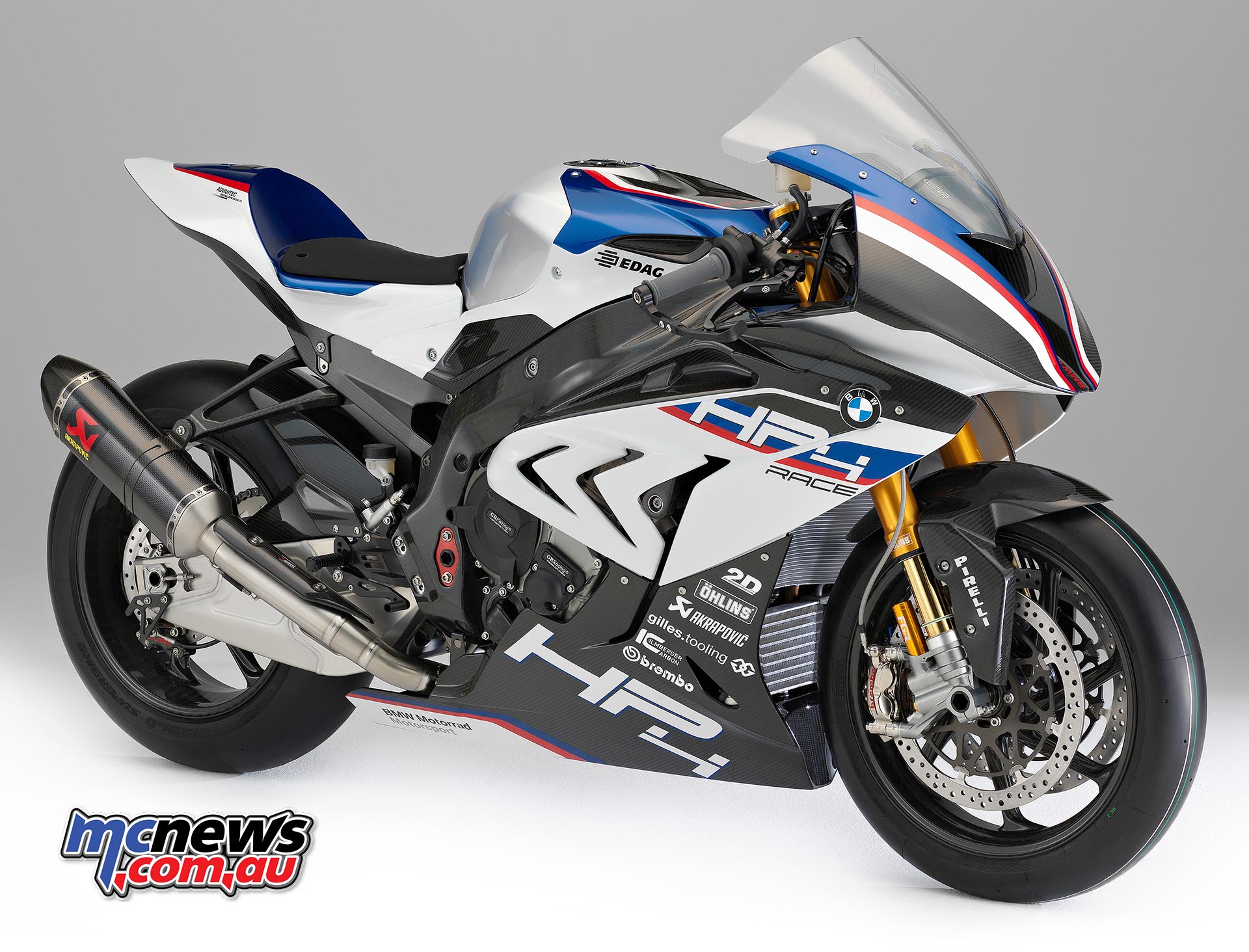Africa Twin improved for 2018
2018 Honda CRF1000L Africa Twin due in Australia April
While MCNews.com.au has already covered the new Adventure Sports model (Link), with its 5.4 litre larger fuel tank and 50mm taller seat height with accompanying increased ground clearance and longer travel suspension aiming that new model at more long-distance intrepid adventurers, Honda have also given the standard model some new features and improvements for 2018.
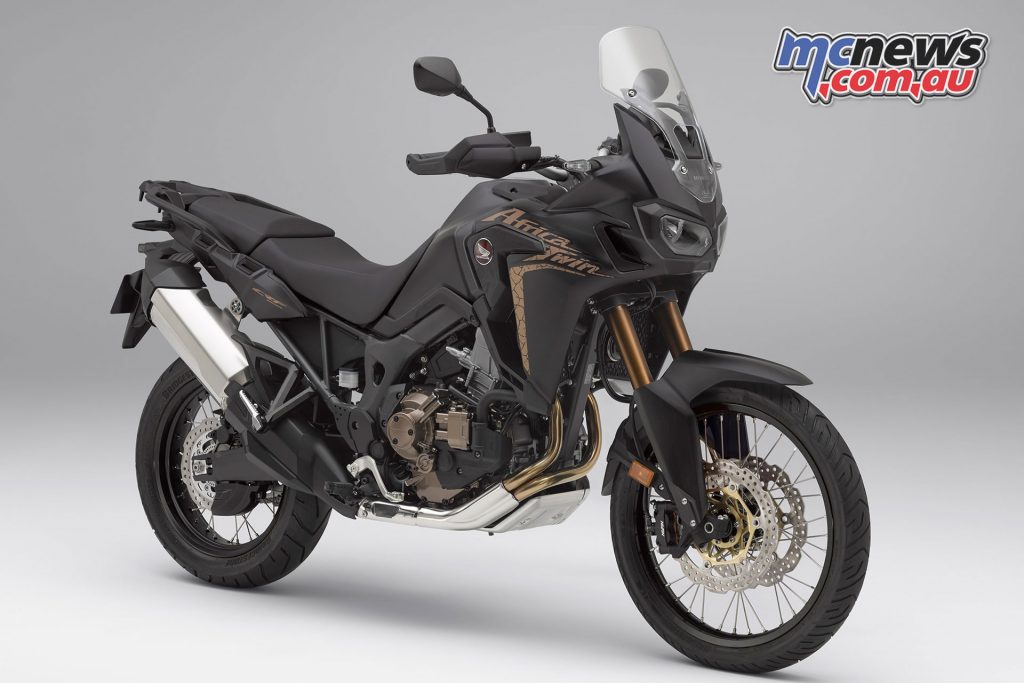
For 2018 Honda is building on the Africa Twin’s strengths, and its success. The base model receives a host of detail upgrades to both manual transmission and Dual Clutch Transmission (DCT) options.
2018 Africa Twin Updates
- New intake design and exhaust aid mid-range response
- New exhaust also designed to improve engine note
- New lighter balance shaft weight
- New lithium-ion battery saves 2.3 kg and enhances durability
- New Throttle By Wire system with four riding modes
- Wet weight 2kg lighter at 230kg (MT version)
- Rider footepgs and pillion footpeg hangers redesigned for off-road use
- Stainless steel spokes improve durability and ease of care
- New Emergency Stop Signal function for rear indicators
Mr K. Morita, Large Project Leader
“Our CRF1000L Africa Twin has proven itself a worthy successor to the original and very much the ‘Go Anywhere’ machine that we set out to make. Over the last two years it’s a motorcycle that’s covered millions of kilometres, and we have received plentiful feedback from owners. For 2018 we have improved the engine’s response, saved weight and given the rider real choice of engine performance and feel. ”
2018 Honda CRF1000L Africa Twin overview
The CRF1000L Africa Twin’s wide-ranging abilities starts with its engine, which has to perform in off-road situations as well as on-road, over long-range tours, short commutes and all points in between.
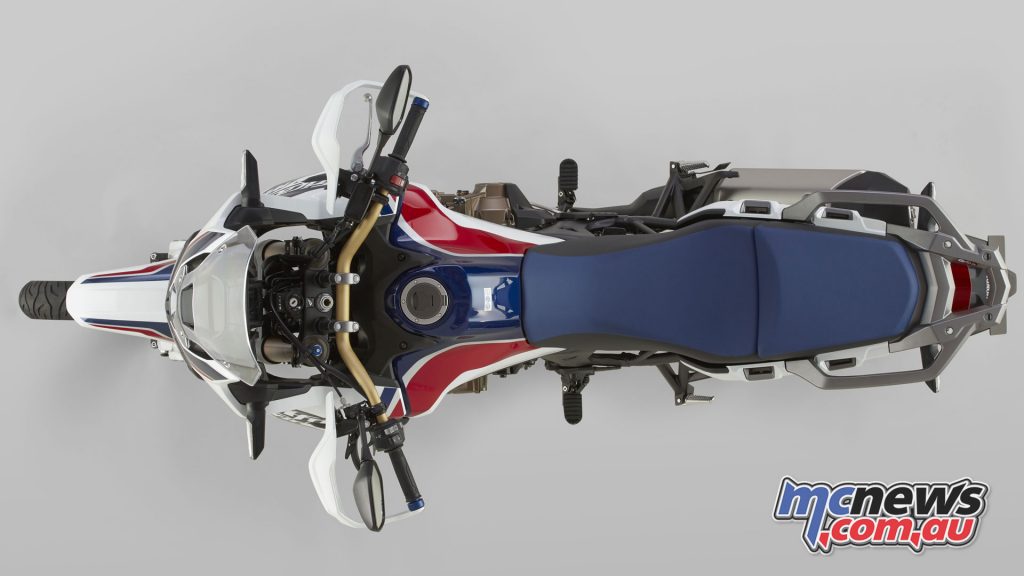
The four-valve 998cc parallel twin Unicam unit’s tractable and usable performance belies its extremely compact dimensions. Longitudinally, it is the same length as Honda’s popular 500cc engine, and its short height contributes to the Africa Twin’s all-important 250mm of ground clearance.
2018 Africa Twin Engine Updates
- New intake design and exhaust aid mid-range response
- New exhaust also designed to improve engine note
- New lighter balance shaft weight
- New lithium-ion battery saves 2.3 kg and enhances durability
For 2018, a modified airbox improves the mid-range response, as does a lighter balancer shaft weight. A revised exhaust serves up an even more evocative howl as revs rise and also contributes to the improved performance.
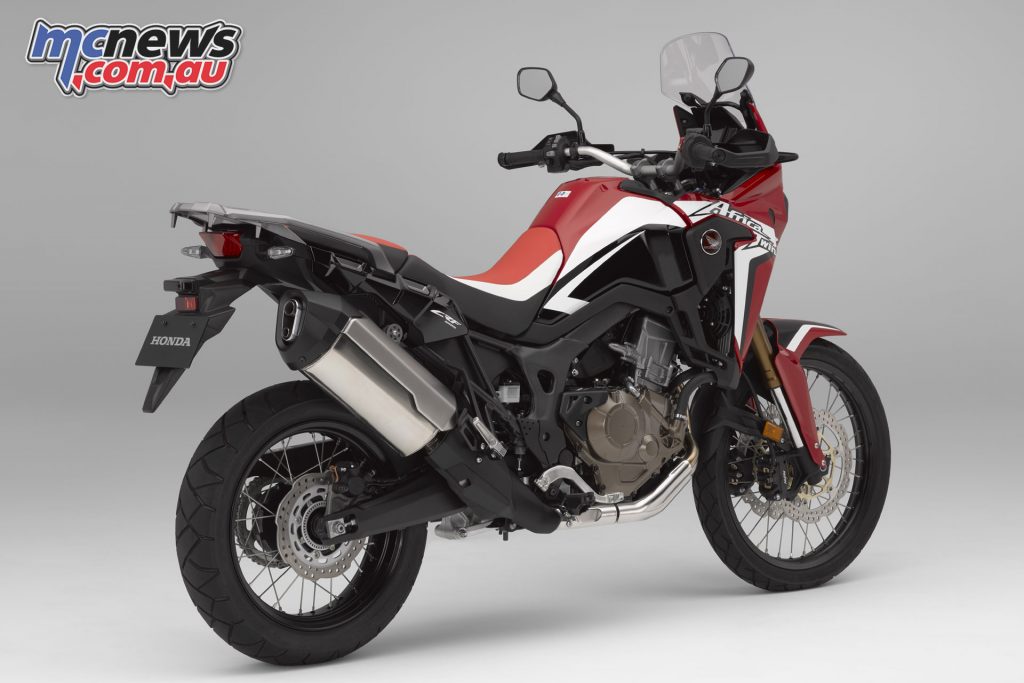
Another significant addition for 2018 is the new Throttle By Wire (TBW) system, which brings with it three riding modes to adjust engine character and output to suit riding conditions. Also new is an extended range of Honda Selectable Torque Control (HSTC) input.
The introduction of TBW greatly expands the choices available to the rider to manage engine output, feel and rear wheel traction. The new system features 7 Levels (previously 3) – from Level 1, for aggressive riding off-road on block pattern tyres, to Level 7 for maximum sense of security on slippery, wet tarmac. It remains possible to turn HSTC completely OFF.
There are also 3 levels of Power and Engine Braking available. In a set-up first used on the RC213V-S – Honda’s street legal version of its MotoGP racer – three riding modes offer pre-set combinations of each parameter, suitable to different riding environments and scenarios.
Africa Twin Riding Modes
- TOUR employs the highest level of Power (1), mid-range Engine Braking (2) and high HSTC (6).
- URBAN uses mid-level Power (2) and Engine Braking (2) and high HSTC (6).
- GRAVEL mode allows the lowest level of Power (3), and EB (3) with high HSTC (6).
- A fourth mode – USER – allows the rider to set and save his or her preferred combination of Power, EB and HSTC levels. Both riding mode and level of HSTC can be changed at any time using the controls on the left hand switchgear.
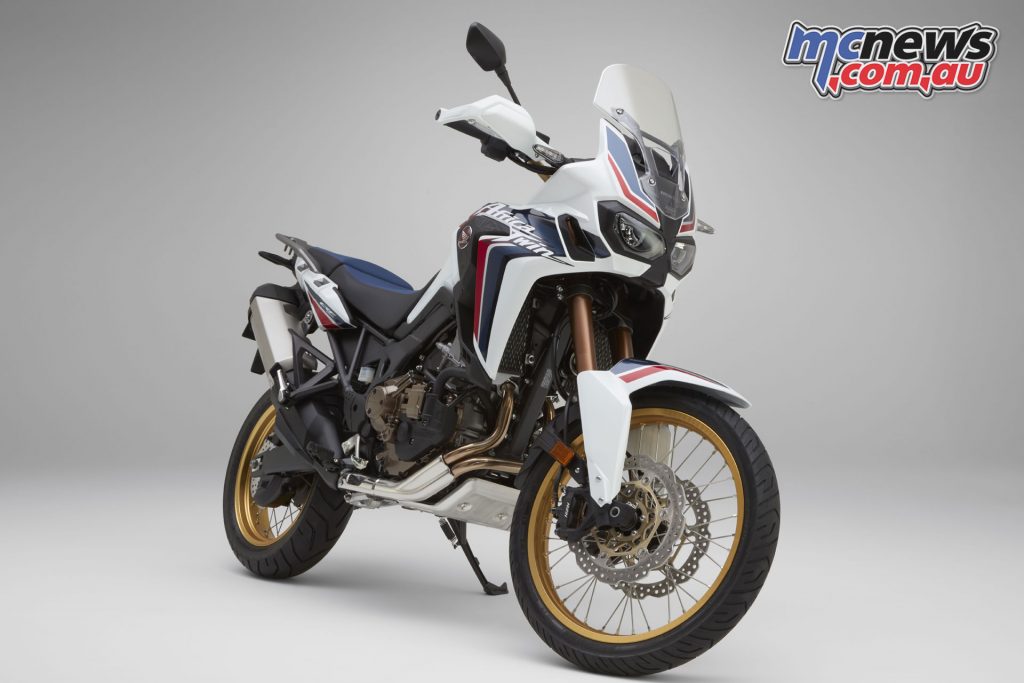
The unique DCT (Dual Clutch Transmission) version features the standard manual mode – allowing the rider to operate gearshifts through triggers on the left handlebar – and two automatic modes. D mode offers the best balance of fuel economy and comfort cruising whilst S mode gives three different, sportier shift patterns to choose from.
The DCT is also fully equipped to operate in an off-road environment and off-road functionality is enhanced by the G button. Pushing the G button in any riding mode modifies the control of the clutch system to give a more direct drive.
2018 Africa Twin Chassis updates
- Wet weight 2kg lighter at 230kg (MT version)
- Rider footepgs and pillion footpeg hangers redesigned for off-road use
- Stainless steel spokes improve durability and ease of care
- New Emergency Stop Signal function for rear indicators
The Africa Twin’s semi-double cradle steel frame provides the balance of high-speed stability and genuine off-road ability by combining strength with flexibility. The engine is mounted on six engine hangers, which keeps vibration to a minimum, avoiding the need for steering dampers. For 2018, the addition of a lithium-ion battery contributes to a 2.3kg overall weight saving.
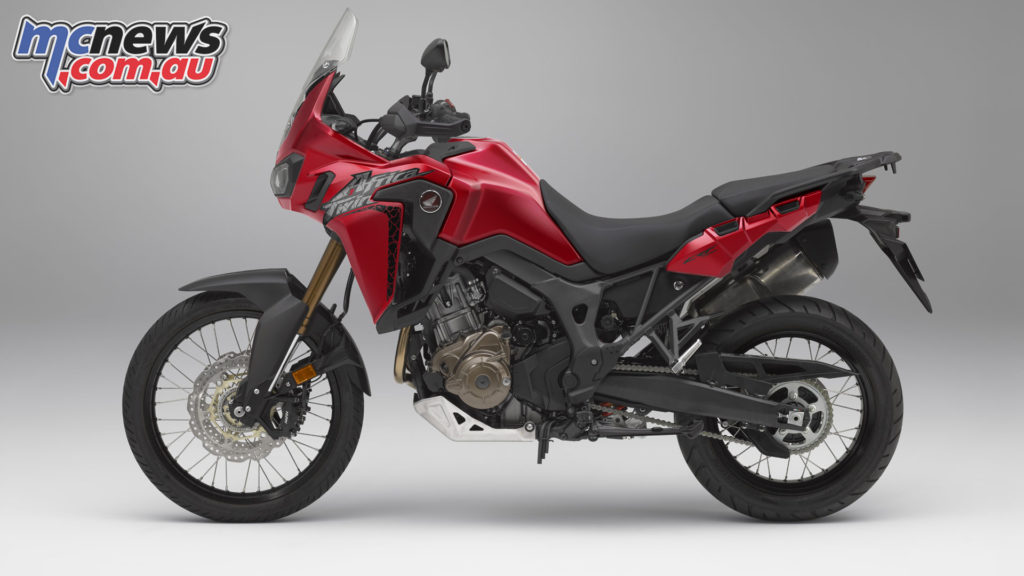
The fully adjustable 45mm Showa inverted forks, fully-adjustable rear shock, dual radial-mount Nissin four-piston brake calipers and 310mm ‘wave’ style floating discs are unchanged for 2018. The 21-inch front and 18-inch rear spoked wheels are now constructed from stainless steel, and for 2018 block tyres are also approved for fitment.
A number of other updates for 2018 will be appreciated by off-road riders: the footpegs are now wider, and feature beefed-up steel mounting plates; the pillion footpeg hangers have also been redesigned to allow more room for the rider’s feet when standing, and the instruments are angled at a shallower angle to allow the rider to see them more easily from a standing position.
For 2018, the rear indicators now also offer an Emergency Stop Signal function. At a minimum speed of 53km/h, with either brake working if negative acceleration of a minimum of 6.0m/s2 is detected, the hazard lights flash to warn other road users a hard stop is in process. At the same speed the threshold is reduced with ABS in play – for wet conditions – to a negative acceleration of a minimum 2.5m/s2.
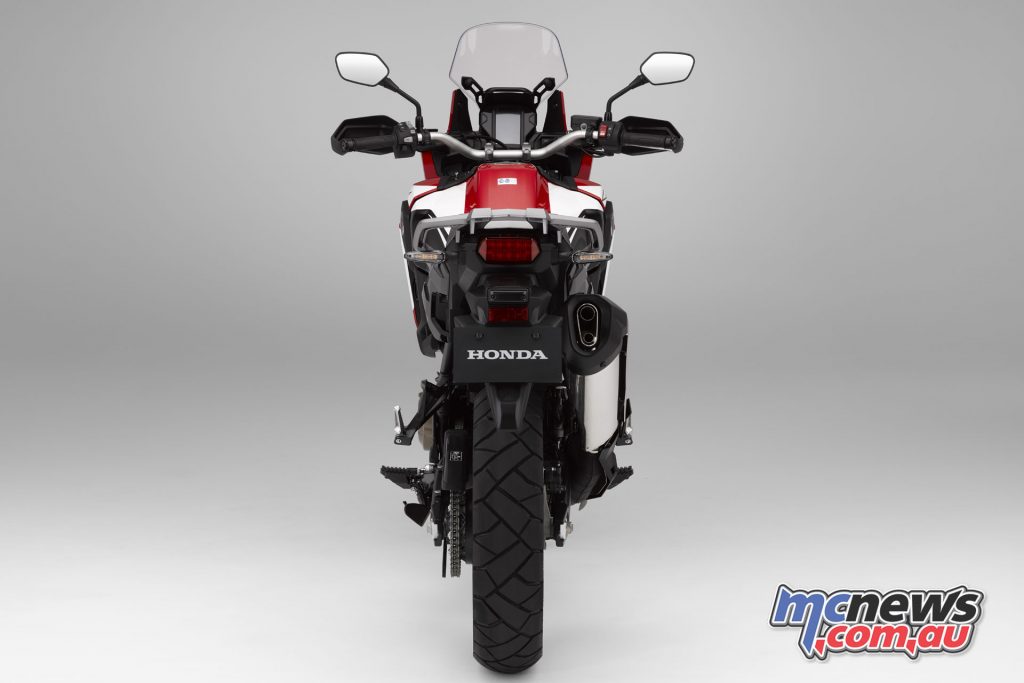
The indicators now also auto-cancel; rather than using a simple timer, the system compares front and rear wheel speed difference and calculates when to cancel the indication relative to the situation.
Like the CRF450R Rally, the CRF1000L Africa Twin uses 21/18-inch front rear spoked wheels, wearing 90/90-21 and 150/70-18 tyres. New for 2018, the spokes are manufactured in stainless steel, improving durability. Also new for 2018 block pattern tyres (Continental 90/90-21M/C 545 and 150/70 B18M/C 70Q, rated at 180km/h and 160km/h respectively) are now approved by Honda for aftermarket fitment and use.
The Africa Twin is styled with minimum bodywork in a tough, lightweight form that offers wind protection for the rider, while dual LED headlights maintain the original’s presence, while the negative LCD meter closely follows the layout of the Dakar race machine.
Seat height adjusts 20mm from the standard 870mm down to 850mm, and an 18.8-litre fuel tank – and the engine’s fuel efficiency of 21.8km/l (WMTC in DCT mode) – provides a range of over 400km.
The 2018 CRF1000L Africa Twin will be available in four colour options: Matt Ballistic Black Metallic, Pearl Glare White (Tricolor), Grand Prix Red (Team HRC Rally colour), and Candy Chromosphere Red.
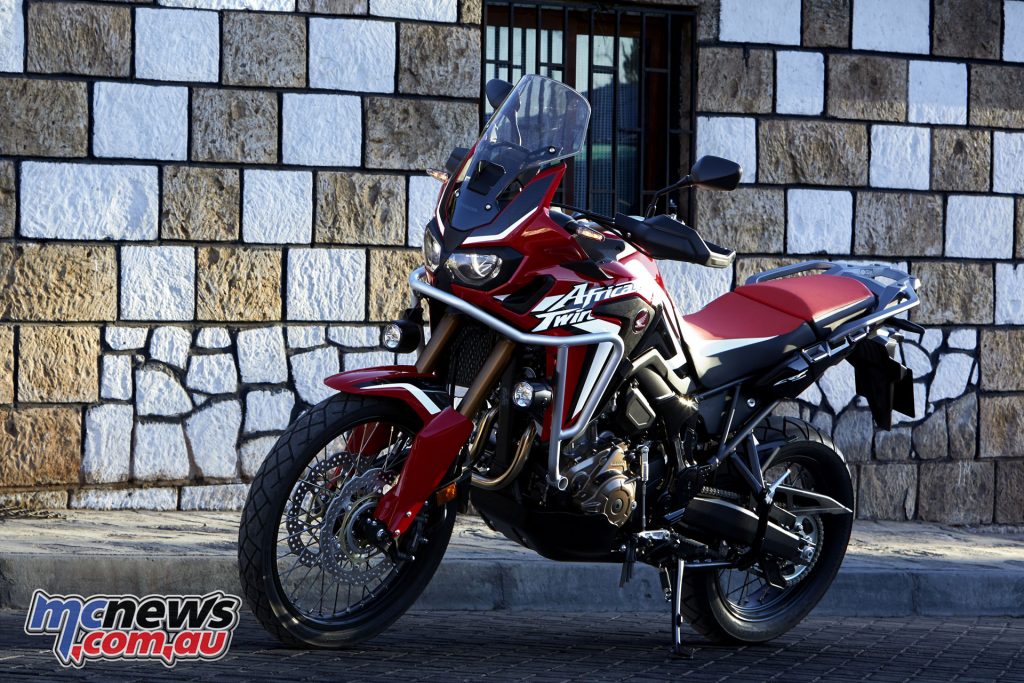
A full range of genuine Honda accessories are available for the CRF1000L Africa Twin, including:
Top box and inner bags, Touring bags, Frame guard, Smoke screen, High screen, Upper and lower wind deflectors, Rubber pillion footpegs, DCT foot shifter, Heated grips, 12V socket, Fog lamps with cowl mounting bar, Wheel stripes, Alarm system, Centre stand, Sump guard, Lower and higher seats, Quickshifter.
2018 Honda CRF1000L Africa Twin Specifications
- Engine – Liquid-cooled 4-stroke 8-valve parallel twin with 270° crank and uni-cam
- Displacement – 998cc
- Bore & Stroke – 92 x 75.1mm
- Max. Power Output – 70kW@7500rpm
- Max. Torque – 99Nm@6000rpm
- Fuel Capacity – 18.8 litres
- Clutch:
- MT – Wet, multiplate with coil springs, Aluminium Cam Assist and Slipper clutch
- DCT – Two wet multiple clutches
- Gearbox – Constant mesh 6-speed MT / 6-speed DCT with on and off-road riding modes
- Final Drive – O-ring sealed chain
- Frame – Steel semi-double cradle type with high-tensile strength steel rear subframe
- Suspension front – Showa 45mm cartridge-type inverted telescopic fork with hydraulic dial-style preload adjuster and DF adjustment, 230mm stroke, 204mm axle travel
- Suspension rear – Monoblock cast aluminium swing arm with Pro-Link with gas-charged damper, hydraulic dial-style preload adjuster and rebound damping adjustment, 220 mm rear wheel travel, 94 mm axle stroke
- Wheels – Wire spoke with aluminium rim, 21 x 2.15in, 18 x 4.00in
- Tyres – 90/90-R21, 150/70-R18 tube type
- ABS – 2-Channel with rear ABS off switch
- Brakes front – 310mm dual wave floating hydraulic disc with aluminium hub and radial fit 4-piston calipers and sintered metal pads
- Brakes rear – 256mm wave hydraulic disc with 1-piston caliper and sintered metal pads. Also Lever-Lock Type Parking Brake System on DCT model with additional slide type 1-piston caliper
- Dimensions (L x W x H) – 2335 x 930 x 1475mm
- Wheelbase – 1575mm
- Seat Height (STD position / Low position) – 870/850mm
- Ground Clearance – 250mm
- Kerb Weight – 230 kg (MT), 240kg (DCT)
- Instruments – Rally style negative LCD instrument display including: Riding Modes, Speedometer, Tachometer, Fuel, Gear position, ABS, HSTC, Odometer, Trip and Clock






